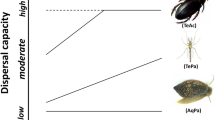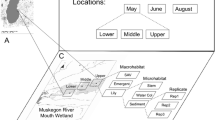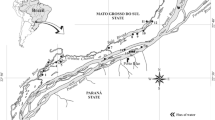Abstract
It is generally recognized that dispersal mode can affect the relative role of environmental and spatial factors in structuring biotic communities. Disentangling the effects of dispersal mode on metacommunity structuring is essential to understanding the mechanisms of community assembly. Despite high seasonal variation in assemblage structure and phenological features of lotic macroinvertebrates, few studies examined the seasonal changes in the relative contribution of environmental and spatial processes. Here, we used two-season (spring and autumn) investigation data to link dispersal mode with local environmental and spatial factors that regulate macroinvertebrate metacommunity in a Chinese high-mountain stream network. Our aims were (1) to disentangle the relative role of environmental and spatial processes on structuring macroinvertebrate with different dispersal ability (aquatic passive: AqPa, terrestrial passive: TePa, and terrestrial active: TeAc) and (2) to determine seasonal shifts in metacommunity structuring processes. We found that assemblages of TeAc (with highest dispersal capacity) in both seasons were influenced more by environmental filtering than spatial structuring, whereas assemblages of TePa were mainly determined by spatial processes. Unexpectedly, AqPa group showed low spatial control in both seasons, probably due to their underestimated dispersal capacity via animal vector. The relative role of environmental and spatial factors was broadly stable across two seasons for AqPa and TeAc groups, but the TePa showed seasonal differences in the relative role of spatial factors, because of their seasonally changing dispersal capacity. In summary, our study emphasizes the use of dispersal mode for understanding metacommunity structuring mechanisms.



Similar content being viewed by others
Data availability
The datasets used and/or analyzed during the current study are available from the corresponding author on reasonable request.
References
Anderson MJ (2006) Distance-based tests for homogeneity of multivariate dispersions. Biometrics 62:245–253
Anderson MJ (2014) Permutational multivariate analysis of variance (PERMANOVA). Wiley Statsref:1–15
Anderson M, Gorley R, Clarke K (2008) PERMANOVA+ for PRIMER: guide to software and statistical methods. PRIMER-E Plymouth, UK
Beche LA, Mcelravy EP, Resh VH (2006) Long-term seasonal variation in the biological traits of benthic-macroinvertebrates in two Mediterranean-climate streams in California, USA. Freshw Biol 51:56–75
Bilton DT, Freeland JR, Okamura B (2001) Dispersal in freshwater invertebrates. Annu Rev Ecol Syst 32:159–181
Boda P, Csabai Z (2013) When do beetles and bugs fly? A unified scheme for describing seasonal flight behaviour of highly dispersing primary aquatic insects. Hydrobiologia 703:133–147
Boersma KS, Lytle DA (2014) Overland dispersal and drought-escape behavior in a flightless aquatic insect, Abedus herberti (Hemiptera: Belostomatidae). Southwest Nat 59:301–302
Borcard D, Legendre P (2002) All-scale spatial analysis of ecological data by means of principal coordinates of neighbour matrices. Ecol Model 153:51–68
Brinkhurst RO (1986) Guide to the freshwater aquatic microdrile oligochaetes of North America. Can Special Publ Fish Aquat Sci 84:1–259
Brown B, Swan C (2010) Dendritic network structure constrains metacommunity properties in riverine ecosystems. J Anim Ecol 79:571–580
Cauvy-Fraunié S, Espinosa R, Andino P, Jacobsen D, Dangles O (2015) Invertebrate metacommunity structure and dynamics in an Andean glacial stream network facing climate change. PLoS One 10:e0136793
Chaves M, Rieradevall M, Chainho P, Costa J, Costa M, Prat N (2008) Macroinvertebrate communities of non-glacial high altitude intermittent streams. Freshw Biol 53:55–76
Chen K, Hughes RM, Xu S, Zhang J, Cai D, Wang B (2014) Evaluating performance of macroinvertebrate-based adjusted and unadjusted multi-metric indices (MMI) using multi-season and multi-year samples. Ecol Indic 36:142–151. https://doi.org/10.1016/j.ecolind.2013.07.006
Cottenie K (2005) Integrating environmental and spatial processes in ecological community dynamics. Ecol Lett 8:1175–1182
Csercsa A, Krasznai-K EÁ, Várbíró G, Szivák I, Tóth M, Árva D, Bódis E, Deák C, Mauchart P, Móra A, Erős T, Padisák J, Boda P (2019) Seasonal changes in relative contribution of environmental control and spatial structuring on different dispersal groups of stream macroinvertebrates. Hydrobiologia 828:101–115
Dudgeon D (1999) Tropical Asian streams: zoobenthos, ecology and conservation. Hong Kong University Press, Hong Kong
Epler JH (2001) Identification manual for the larval Chironomidae (Diptera) of North and South Carolina. St. Johns River Water Management District
Erős T, Sály P, Takács P, Specziár A, Bíró P (2012) Temporal variability in the spatial and environmental determinants of functional metacommunity organization-stream fish in a human-modified landscape. Freshw Biol 57:1914–1928
Frisch D, Green AJ, Figuerola J (2007) High dispersal capacity of a broad spectrum of aquatic invertebrates via waterbirds. Aquat Sci 69:568–574
Furse M, Moss D, Wright J, Armitage P (1984) The influence of seasonal and taxonomic factors on the ordination and classification of running-water sites in Great Britain and on the prediction of their macro-invertebrate communities. Freshw Biol 14:257–280
Gilbert B, Bennett JR (2010) Partitioning variation in ecological communities: do the numbers add up? J Appl Ecol 47:1071–1082
Gómez-Rodríguez C, Freijeiro A, Baselga A (2015) Dispersal and ecological traits explain differences in beta diversity patterns of European beetles. J Biogeogr 24:383–395
Göthe E, Angeler DG, Sandin L (2013) Metacommunity structure in a small boreal stream network. J Anim Ecol 82:449–458
Göthe E, Baattrup-Pedersen A, Wiberg-Larsen P, Graeber D, Kristensen EA, Friberg N (2017) Environmental and spatial controls of taxonomic versus trait composition of stream biota. Freshw Biol 62:397–413
Heino J (2013) Does dispersal ability affect the relative importance of environmental control and spatial structuring of littoral macroinvertebrate communities? Oecologia 171:971–980
Heino J, Mykrä H (2008) Control of stream insect assemblages: roles of spatial configuration and local environmental factors. Ecol Entomol 33:614–622
Heino J, Soininen J (2010) Are common species sufficient in describing turnover in aquatic metacommunities along environmental and spatial gradients? Limnol Oceanogr 55:2397–2402
Heino J, Melo AS, Siqueira T, Soininen J, Valanko S, Bini LM (2015) Metacommunity organisation, spatial extent and dispersal in aquatic systems: patterns, processes and prospects. Freshw Biol 60:845–869
Heino J, Soininen J, Alahuhta J, Lappalainen J, Virtanen R (2017) Metacommunity ecology meets biogeography: effects of geographical region, spatial dynamics and environmental filtering on community structure in aquatic organisms. Oecologia 183:121–137
Huang X, Chen W, Cai Q (1999) Standard methods for observation and analysis in Chinese ecosystem research network-survey, observation and analysis of lake ecology. Standards Press of China, Beijing
Jacobsen D (2008) Low oxygen pressure as a driving factor for the altitudinal decline in taxon richness of stream macroinvertebrates. Oecologia 154:795–807
Jiang J, Wen FN, Qiu S, Wang LX, Yan YJ (2011) Production dynamics and mass flux of dominant chironomid species in Hujiaxi stream of Qingjiang River. Chin J Ecol 30:2540–2546
Jiang X, Xie Z, Chen Y (2013) Longitudinal patterns of macroinvertebrate communities in relation to environmental factors in a Tibetan-Plateau river system. Quat Int 304:107–114
Jiang X, Xiong J, Xie Z (2017) Longitudinal and seasonal patterns of macroinvertebrate communities in a large undammed river system in Southwest China. Quat Int 440:1–12
Landeiro VL, Bini LM, Melo AS, Pes AMO, Magnusson WE (2012) The roles of dispersal limitation and environmental conditions in controlling caddisfly (Trichoptera) assemblages. Freshw Biol 57:1554–1564
Lansac-Tôha FM, Heino J, Quirino BA, Moresco GA, Peláez O, Meira BR, Rodrigues LC, Jati S, Lansac-Tôha FA, Velho LFM (2019) Differently dispersing organism groups show contrasting beta diversity patterns in a dammed subtropical river basin. Sci Total Environ 691:1271–1281
Legendre P, Anderson M (1999) Distance-based redundancy analysis: testing multispecies responses in multifactorial ecological experiments. Ecol Monogr 69:1–24
Legendre P, Legendre L (1998) Numerical Ecology. Elsevier, Amsterdam
Leibold MA, Chase JM (2017) Metacommunity ecology vol 59. Princeton University Press
Leibold MA, Holyoak M, Mouquet N, Amarasekare P, Chase JM, Hoopes MF, Holt RD, Shurin JB, Law R, Tilman D, Loreau M, Gonzalez A (2004) The metacommunity concept: a framework for multi-scale community ecology. Ecol Lett 7:601–613
Leung AS, Dudgeon D (2011) Scales of spatiotemporal variability in macroinvertebrate abundance and diversity in monsoonal streams: detecting environmental change. Freshw Biol 56:1193–1208
Li F, Sundermann A, Stoll S, Haase P (2016) A newly developed dispersal metric indicates the succession of benthic invertebrates in restored rivers. Sci Total Environ 569:1570–1578
Li Z, Wang J, Meng X, Heino J, Sun M, Jiang X, Xie Z (2019) Disentangling the effects of dispersal mode on the assembly of macroinvertebrate assemblages in a heterogeneous highland region. Freshw Sci 38:170–182
Milner AM, Brittain JE, Castella E, Petts GE (2001) Trends of macroinvertebrate community structure in glacier-fed rivers in relation to environmental conditions: a synthesis. Freshw Biol 46:1833–1847
Morse JC, Yang L, Tian L (1994) Aquatic insects of China useful for monitoring water quality. Hohai University Press, Nanjing
Mykrä H, Heino J, Muotka T (2008) Concordance of stream macroinvertebrate assemblage classifications: how general are patterns from single-year surveys? Biol Conserv 141:1218–1223
R Developement Core team (2020) R: a language and environment for statistical computing. Vienna, Austria: Foundation for Statistical Computing. http://www.R-project.org
Sarremejane R, Cañedo-Argüelles M, Prat N, Mykrä H, Muotka T, Bonada N (2017) Do metacommunities vary through time? Intermittent rivers as model systems. J Biogeogr 44:2752–2763
Schmera D, Árva D, Boda P, Bódis E, Bolgovics Á, Borics G, Csercsa A, Deák C, Krasznai EÁ, Lukács BA, Mauchart P, Móra A, Sály P, Specziár A, Süveges K, Szivák I, Takács P, Tóth M, Várbíró G, Vojtkó AE, Erős T (2018) Does isolation influence the relative role of environmental and dispersal-related processes in stream networks? An empirical test of the network position hypothesis using multiple taxa. Freshw Biol 63:74–85
Sgarbi LF, Bini LM, Heino J, Jyrkänkallio-Mikkola J, Landeiro VL, Santos EP, Schneck F, Siqueira T, Soininen J, Tolonen KT, Melo AS (2020) Sampling effort and information quality provided by rare and common species in estimating assemblage structure. Ecol Indic 110:105937
Soininen J (2016) Spatial structure in ecological communities–a quantitative analysis. Oikos 125:160–166
Tonkin JD, Altermatt F, Finn DS, Heino J, Olden JD, Pauls SU, Lytle DA (2018) The role of dispersal in river network metacommunities: patterns, processes, and pathways. Freshw Biol 63:141–163
Townsend CR (1989) The patch dynamics concept of stream community ecology. J N Am Benthol Soc 8:36–50
van Leeuwen CH, Van der Velde G, van Groenendael JM, Klaassen M (2012) Gut travellers: internal dispersal of aquatic organisms by waterfowl. J Biogeogr 39:2031–2040
Wang L, Xu H, Jiang M (2004) Biodiversity of Tianquanhe River Rare Fish Nature Reserve and Its Sustainable Development Strategies. Sichuan Environ 5:25–28
Wang J, Legendre P, Soininen J, Yeh CF, Graham E, Stegen J, Casamayor EO, Zhou J, Shen J, Pan F (2020) Temperature drives local contributions to beta diversity in mountain streams: stochastic and deterministic processes. Glob Ecol Biogeogr 29:420–432
Ward J, Tockner K, Arscott D, Claret C (2002) Riverine landscape diversity. Freshw Biol 47:517–539
Wiggins GB (1996) Larvae of the North American caddisfly genera (Trichoptera), 2nd edn. University of Toronto Press, Toronto
Wright JS (2002) Plant diversity in tropical forests: a review of mechanisms of species coexistence. Oecologia 130:1–14
Yan Y, Li X (2007) Secondary production of several dominant macrozoobenthos in Heizhuchong Stream of Hanjiang River Basin. Acta Hydrobiol Sin 31:297–306
Zhao K, Song K, Pan Y, Wang L, Da L, Wang Q (2017) Metacommunity structure of zooplankton in river networks: roles of environmental and spatial factors. Ecol Indic 73:96–104
Zhou C, Gui H, Zhou K (2003) Larval key to families of Ephemeroptera from China (Insecta). J Nanjing Normal Univ 26:65–68
Acknowledgements
This work was financially supported by the National Natural Science Foundation of China (No. 31770460). We thank four anonymous reviewers and the editor for helpful comments that improved this article. Special thank is given to Dr. Jani Heino of Freshwater Centre, Finnish Environment Institute for valuable suggestion in the revision of this article.
Funding
This work was supported by the National Natural Science Foundation of China (No. 31770460).
Author information
Authors and Affiliations
Contributions
XJ and HL conceived the ideas; XX, MT, XJ, and SZ collected the data; XJ and ZL analyzed the data; XJ led the writing of the manuscript.
Corresponding author
Ethics declarations
Ethics approval and consent to participate
Not applicable.
Consent for publication
Not applicable.
Competing interests
The authors declare that they have no competing interests.
Additional information
Responsible Editor: Thomas Hein
Publisher’s note
Springer Nature remains neutral with regard to jurisdictional claims in published maps and institutional affiliations.
Supplementary Information
ESM 1
(DOCX 61 kb)
Rights and permissions
About this article
Cite this article
Jiang, X., Xu, X., Tao, M. et al. The effects of dispersal ability on metacommunity structure of macroinvertebrates in subtropical Chinese high-mountain streams: seasonal shifts in relative contribution of local environment and spatial processes. Environ Sci Pollut Res 28, 38573–38583 (2021). https://doi.org/10.1007/s11356-021-13281-2
Received:
Accepted:
Published:
Issue Date:
DOI: https://doi.org/10.1007/s11356-021-13281-2




